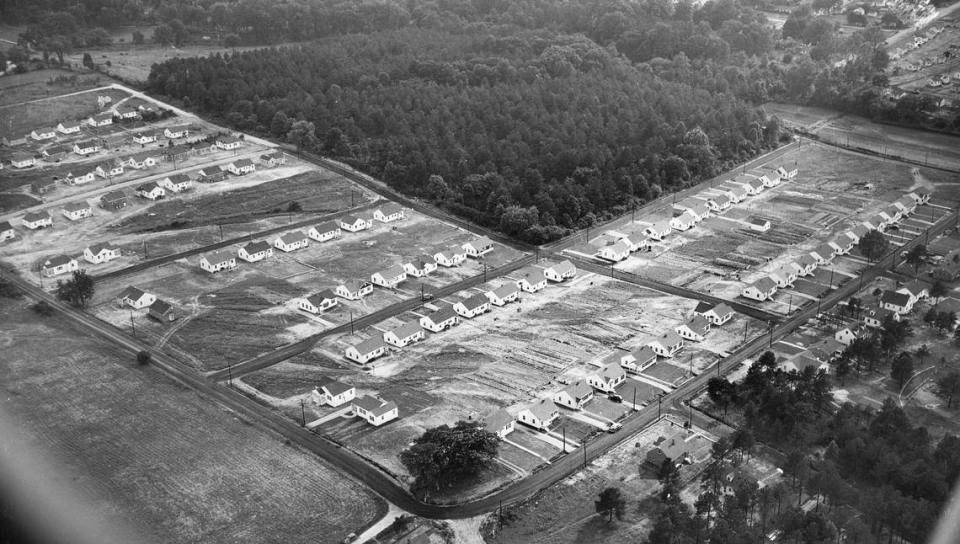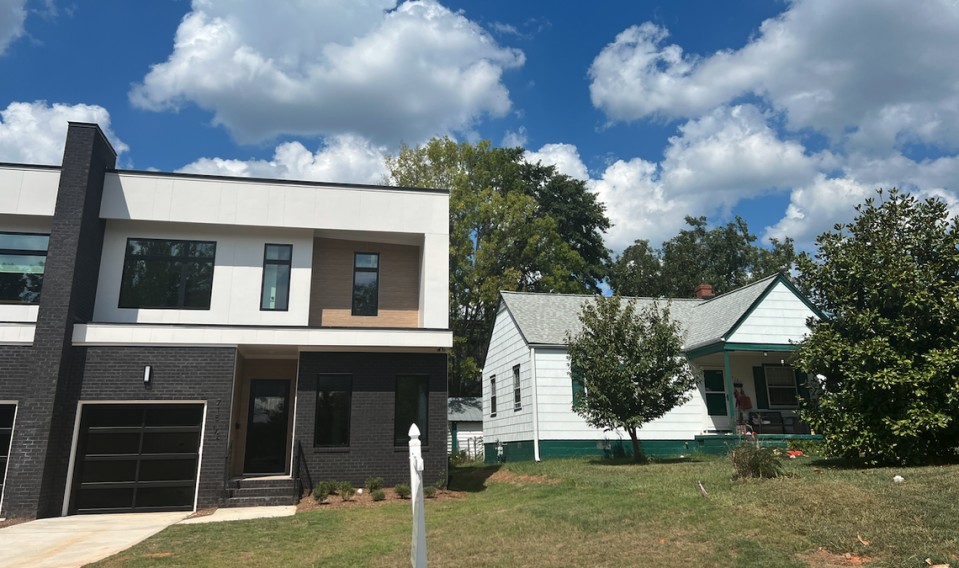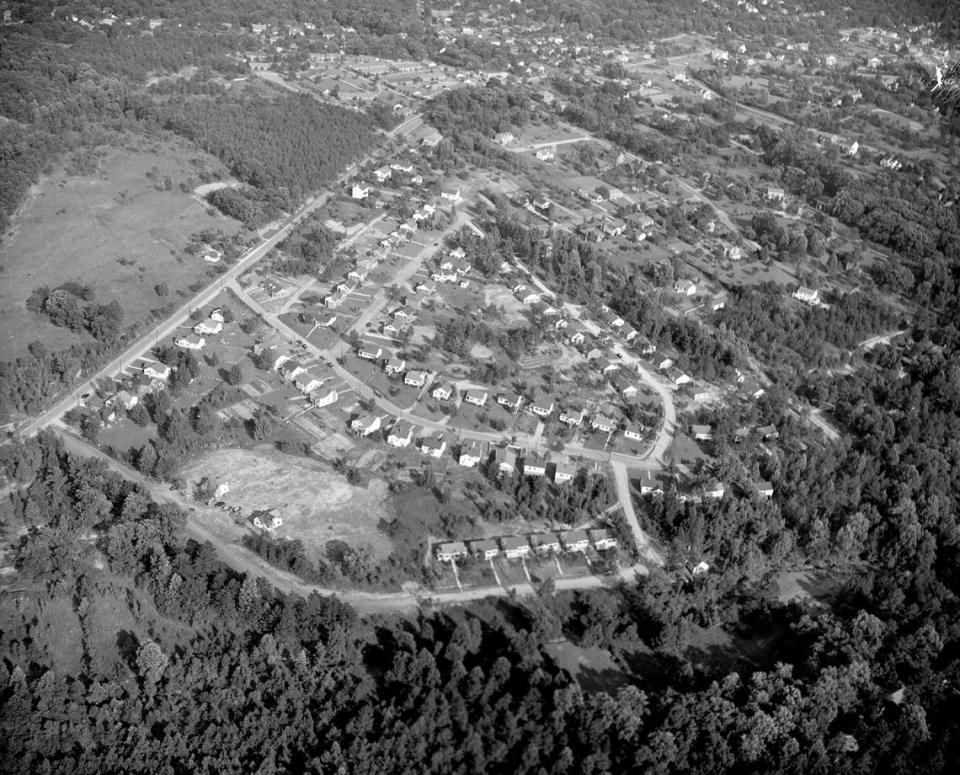Triangle’s ‘Missing Middle’ housing: Where did it go? What can bring it back?
In 1993, when Paul Kane was starting out, he found a broken-down rental house, built in 1941, for $55,000 — around $170,000 in today’s dollars.
The 1,700-square-foot one-story house that he fondly called his “starter home” had been “through the wringer.” But after ripping up the carpet and replacing the sewer line, he flipped it four years later at a profit.
“I sold it for double what I’d paid,” said Kane, 57, now the chief executive of the Home Builders Association of Raleigh-Wake County.
Fast forward to 2023: In Northeast Raleigh, he has a daughter in her 20s, living at home, saving for her first down payment. After working in the construction industry for the last 30 years, he knows she won’t find anything remotely resembling his first home.
“Those homes don’t really exist anymore,” Kane said. “Below $1 million, there’s not one-month inventory of anything.”
Kane won’t declare the starter home dead for millennials and Gen Z-ers like his daughter. “People just have to be creative in terms of how they do that.”
Despite a post-pandemic construction boom, the Triangle is facing a massive housing shortfall. Starting with the 2008 subprime mortgage crisis, builders have been working at a deficit to meet demand. Today’s rising land costs — and local land-use policies requiring minimum sizes and quality, higher-priced materials — have only driven up costs, making it harder, they say.
Inventory at all price points, from “condos to luxury homes,” is critically low. Small, detached single-family homes priced under $300,000 are even scarcer.
“It’s economics 101,” Kane said. “We haven’t kept up with demand, and inventory is nonexistent. It’s now reached a boiling point.”
That crunch is hitting just when millennials, ages 27 to 42, are in “full-fledged home-buying” mode. A sharp jump in mortgage rates — near a 25-year high — is adding further pressure, locking current homeowners in place, propping up prices and inflating rents.
The result is a growing housing affordability crisis, squeezing the so-called “missing middle” — people earning 80% to 120% of the median income. They’re a typical family, likely a two-income household. They often work in the service industries: teachers, nurses, police officers. They earn just enough to be excluded from any type of government subsidies, but not enough to get into the house of their needs. (It’s even harder for Black homebuyers. In 2022, just 3% of buyers were Black — down from 6% the year prior.)
Nationwide, these buyers are being sidelined. In places like Wake County, where a post-pandemic influx of residents — 62 people a day — is fueling the surge, they have even fewer options.
The Raleigh metro area alone needs at least 17,000 more units, according to a recent Zillow study. Statewide, experts put that number closer to 900,000 new homes needed over the next decade.
“Trends suggest that the state won’t come close,” said Michael Tanner, a fellow at the libertarian Cato Institute.
What is ‘missing middle’ housing?
Across the Triangle, leaders are working to bring back more “missing middle” housing. That includes a range of multifamily or clustered housing types more common pre-World War II and the push toward suburban sprawl: duplexes, townhouses and backyard cottages (officially called accessory dwelling units). Prior to 2021, these housing types were prohibited in many neighborhoods. They’re more affordable and appeal to a diversity of buyers, from young professionals to empty nesters.
But in all corners — Raleigh, Durham, Chapel Hill — these types of housing have received pushback. After recent elections, the landscape remains uncertain.
From a builder’s view, the biggest factor is the cost of dirt. Typically, land is about 20% of a new home’s final sale price. In Raleigh, a lot may cost $200,000. Putting a small, detached home on increasingly expensive land just doesn’t add up.
“We can’t make the math work,” said Alaina Money-Garman, chief executive of Cary-based Garman Homes, which is behind Chatham County’s tiny home village project for people with mental illness. “That’s our whole business, staying at the midpoint or lower.”
But at some point, it’s beyond their control, she said. “The market sets the price.”
In coveted neighborhoods like Raleigh’s historic Capitol Heights district, a home sells regardless of what’s on the lot. Given construction costs, builders will most likely build bigger and more expensive homes, where the margins are better. Another result is homes once built as entry-level housing become targets for tear-downs.

A one-story, 1940s-era home on Van Buren Road sold for $330,000 in 2021, tax records show. It’s since been replaced with a million-dollar-plus modernist duplex. (One unit sold in July for $965,000; the other is currently listed for $975,000.) In some neighborhoods, almost entire blocks have been torn down, displacing many lower-income residents.
“To build a $250,000 home, you’d need to drive toward Wendell, Zebulon, Angier or even further out,” said Tri Pointe Homes land acquisition director Amanda Hoyle, where land and construction prices “might work at that price point.”
“Land is so expensive now in the Triangle’s inner core, like Raleigh and Durham, that to make the project pencil out, you’re pretty much required to do townhomes,” Hoyle said.
The California-based homebuilder is among a growing number of out-of-state developers buying up large swaths of land since 2018. It currently has 12 new projects in development or under construction across the Triangle. Eight of those are townhome communities, including a 102-unit project in Durham. At 12 units per acre, prices will start in the mid-$400,000s.

That’s increasingly becoming the “entry-point” for the Triangle’s inner suburbs, say experts.
While there are some signs of cooling after historic mid-2022 peaks, prices remain high. A median Raleigh home price was still $440,000 in August, Redfin found. With today’s rates and a 20% down payment, it equates to a median monthly mortgage payment around $3,000.
That’s steep for someone who earns around $88,471, Wake County’s median household income. You’d need to earn $30,000 more — $120,000 — to afford a median-priced home, per Redfin data. That’s more than a 17% spike in required income year-over-year — and above the national average.
That affordability gap has spread across the region, experts warn.
Triangle Multiple Listing Service (TMLS), a Cary-based real estate listings platform, tracks affordability using a third-party vendor, MarketStats, for its index.
“Currently, no area in the 16-county Triangle area is affordable for middle-income households according to the index,” said Matt Fowler, TMLS’ executive director. “We have a dramatic undersupply of property that real people can buy.”

What can bring it back?
In 2019, Durham voters overwhelmingly approved the city’s $95 million affordable housing bond. A year later, Raleigh passed a similar $80 million affordable housing bond. The city has also helped launch its own land trust.
But housing advocates say that won’t be enough to combat rising housing costs. They’re calling for an overhaul of local residential zoning codes, allowing for more density in traditionally single-family neighborhoods.
“[It’s] the most effective way,” said Eric Maribojoc, a UNC professor who focuses on affordable housing. “Without such strategies, prices and rents will continue to rise.”
Even in cases where density doesn’t always equate to affordability, it adds value, he argued. “If it creates supply, it makes the whole community more affordable by definition.”
In Raleigh and Chapel Hill, leaders passed controversial reforms to allow for a variety of housing types without rezoning. In Durham, developers are hoping to rewrite rules to allow for more density in their neighborhoods.
The shifting landscape has led to a construction boom of denser types of housing. While permits for single-family houses dropped by 11.2% during the first half of this year, building permits for units in two- to four-unit buildings surged 145% year-over-year, according to real estate website Point2Homes.
Some 10,922 apartments are also on track to be built in the Raleigh-Cary metro area alone by year’s end. That’s a six-year peak, surpassing large hubs like Seattle and San Francisco, RentCafe found.
Site work is underway on The Weld, a 1,200-unit mixed used development at the southern edge of the 308-acre Dorothea Dix Park. 320 W South, a 20-story project in the Warehouse District, is also under construction, adding 296 apartments and 30,000 square feet of amenity space.
The surge is spilling beyond the Triangle’s edges. ZIP code 27526 in Fuquay-Varina more than tripled its supply of apartments — from 563 in 2017 to 1,781 in 2022 — a 216% boost. That’s the fourth highest percentage growth in the nation.
The backlash
But not everyone is on board.
Local rules seeking to create “gentle density” have sparked public outcry in certain pockets, often pitting city officials and developers against concerned residents.
Opponents question builders’ motives. They’re also worried about the changing character of their neighborhoods.
In Raleigh’s Hayes Barton neighborhood, one of the city’s wealthiest, developers plan to replace a 100-year-old home with 17 townhouses, each with a price tag of roughly $2 million. After forming the “Save Our Neighborhood” group, six residents are suing the city over the reforms and planned townhouses.
In Durham, where developers have submitted an 87-page rewrite of the code called SCAD — short for Simplifying Codes for Affordable Development — reforms dominated the election cycle. Leaders postponed their vote until Nov. 20, after the election but before the new council is sworn in.
Two amendments in particular are sticking points. One would eliminate parking minimums for new buildings, as Raleigh has done; the other would change the city’s affordable housing bonuses in exchange for density.
“The vast majority of SCAD’s provisions have nothing to do with housing affordability,” wrote Tom Miller, a former Preservation Durham board member and planning commissioner, in a series of essays representing the Watts-Hillandale community. Instead, they’re designed to line developer’s pockets, he argued.
Small-scale developer Topher Thomas, however, challenged that notion in an October meeting. “I want to say, number one, I’m poor,” Thomas said. “And yet, I am a developer. In the past two years, I’ve built eight homes, and those eight homes have housed refugees, folks with disabilities, immigrants and low-income folks exclusively. What SCAD does for me is it expands the imagination.”
Going forward
Strong economic headwinds also threaten builders’ momentum and this current boom.
The still-rising costs of construction materials, labor and land, and the tightening of bank lending standards are making it harder to seal deals, said CBRE|Raleigh executive vice president Chester Allen.
In general, construction debt starts at 8% interest, and most banks only lend 60% or less of the total cost of a project.
“The amount of equity needed is significantly higher than just a few years ago,” Allen said. In particular, it’s challenging times for new multifamily development deals requiring internal parking. “They’re significantly more expensive to build, therefore they have to charge higher rents,” he said.
Nationwide, the number of new apartments is expected to drop by 16% year-over-year — from 506,574 in 2024 to 424,899 in 2025, according to Yardi Matrix estimates.
New completions will bottom out in 2026 at approximately 401,065 units. The pace of construction is projected to gradually recover in 2027 and 2028, Yardi Matrix said.
“Long term, we’ll be OK, but it’s making it difficult in the short term,” Allen said.
If builders can’t get projects financed and through the development pipeline, numbers might start to fall off a cliff in the Triangle as they have elsewhere. Then this construction boom might just have been a blip on the radar.
Reporter Mary Helen Moore contributed to this report.

